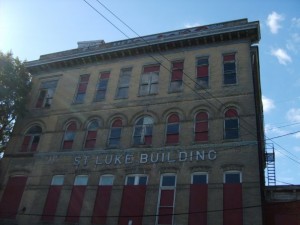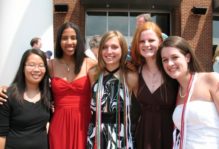Once a Sharpie, Always a Sharpie
I have many memories of my experiences as a Sharpe Scholar my first year at William and Mary, and as I was warned that first year: once a Sharpie, always a Sharpie. That year in the Sharpe Program strongly influenced both my undergraduate years and my continued life choices. That year set me on my way to becoming a Sharpe Teaching Fellow, living in the Community Scholars House for three years, and beginning my addition to the Office of Community Engagement & Scholarship. Sharpe also helped me define my personal commitment to focusing my scholarship on issues of community and social identities and developed my daily investment in living out the values of equality, social justice, and active citizenship.
As I was recently cleaning out my Google Documents, I found something I wrote my freshman year about my experience in the Sharpe Program. Monica Griffin, Director of the Sharpe Program, had asked a few of us to speak to the Board of Visitors about Sharpe and what it meant to us, and this was what I drafted in preparation:
“The Sharpe Program has changed not only my service experience but my William and Mary experience. Most community service programs ask you to give of yourself: give your time and your skill. Sharpe asks for these only as prerequisites. What Sharpe really asks you to do is engage, and when you feel like disengaging—when a community partner frustrates or you feel like the reading is going to swallow you—Sharpe asks you to keep pushing and realize that you are no longer just giving of yourself. If it were just you, then you giving up would not make that much of a difference. Sharpe instead makes you realize you are a part of a collective: your classmates and professor, other members of the Sharpe program, community partners, all relying on each other. Even larger than that is the history, the people and the choices that came before you, and the possible future you are trying to create.
My particular seminar focuses on Maggie Lena Walker. I don’t know how much you know of her. I knew nothing until I googled her over the summer. Here are some interesting facts. Maggie Walker was the first female bank owner. She ran a newspaper, a store, and led the Independent Order of St. Luke. She strived for economic independence for women, African Americans, and her community as a whole. She also struggled with the prejudices against Black women during the Jim Crow era. If I were in a lecture class about Maggie Walker, these, along with many other facts, would be the kind of knowledge I could bring you today. Instead, the breadth of knowledge my seminar has brought me is quite astounding. The best way I can think of describing it is this: In a lecture class we might look at a series of neighborhood photographs and say, “Look at the houses in these photographs. What can we learn from the houses?” In my Sharpe seminar we get only one photograph and we ask, “What can we see in the one photograph?” We study everything from the houses, to the cars, to the people, to the blades of grass. We spend a semester with that one photograph. Because of this we become intimate with many aspects of our topic, to the point that it becomes more than a photograph, but rather a mental image. Once that image is in your mind you’re committed.
Maggie Walker, as I mentioned, owned a bank. In the North Jackson Ward district of Richmond, there still stands a structure with large letters reading St. Luke Building. Inside the building you will find a bank vault and a bank window. You will also find that the pressed tin ceiling has been ripped down to get at the copper piping above it. Watch your step because you will find dead pigeons, broken bottles, and countless other shattered objects on the floor. The plaque that used to commemorate Maggie Walker and the St. Luke Building is only a memory in the four screw holes that held it to the wall.

The St. Luke Building on my first visit freshman year. I still glance at it when I drive through Richmond.
This was not the mental image my seminar had come to create; it was instead the sad reality that we are working to change. While the building is a very graphic symbol of what has happened to the history and legacy of Maggie Walker, it is not the core of our efforts. Instead what our class has been inspired by is the community of North Jackson Ward. A struggling population, mainly African American, North Jackson Ward is about to undergo extensive redevelopment. We want to help create a place for the community to come together during this time of change and live the values that Maggie Walker so cherished.What we want most is a use for the space that keeps the historic character of the building while directly serving the people.
While I have expanded beyond Sharpe to take on volunteer opportunities that make me feel good as soon as I show up, Sharpe satisfies a completely different need. As I said before, it’s not service, it’s engagement. It is recognizing that there is more than what you want, and more than you thought you could give. It’s looking at one photograph and saying what now?”
I continue to ask myself “what now” as I consider how to make the best impact on the many communities I am a part of (including my Tribe family), and I remain grateful for all that I learned from my Sharpe engagement experience.
Comments are currently closed. Comments are closed on all posts older than one year, and for those in our archive.




What are the chances that my quick glance at what’s going on in the W&M world would come across a Maggie Walker blog?
Even though I took a little different route after graduation, MaWa and Sharpe will ALWAYS be a huge part of my memories from W&M, and I still use my MaWa Sharpie pen all the time 🙂
Big E